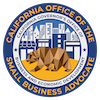Advice from the SBDC helped this entrepreneur grow by reducing costs and obtaining capital.
Click & Carry is a simple device that allows shoppers to conveniently carry multiple bags comfortably developed by Kimberly Meckwood, an entrepreneur with an idea and a background in medical devices.
Challenges
Meckwood began to dedicate her time to Click & Carry full-time in March 2013 and officially launched the product at a Home and Housewares show. The launch was successful, however Meckwood required additional working capital before she could further expand her business to new prospects. Just at the right time, a friend recommended the Small Business Development Center hosted by Pasadena City College.
Best Advice
SBDC Business Advisors Don Loewel and Albert Napoli helped Meckwood: price her product competitively, develop a business plan, and identify and pitch to investors. Ultimately, the SBDC helped Meckwood both obtain an SBA loan and secure equity financing.
“The SBDC give me expert advice and they are honest with me. I would have made many mistakes without their council. I honestly can’t make a big decision without running it by my “dream team” first. They are knowledgeable, insightful, rational and strategic. It’s an honor to work with my two brilliant advisors! I can’t tell you how thankful I am for the SBDC. They changed my life!”
Kimberly Meckwood, Founder, Click & Carry, Inc.
Price It Right
The Click & Carry initial launch proved to be successful as Meckwood secured contracts with large retailers including Ralph’s and the Container Store in addition to shopping networks like QVC. Nevertheless, Meckwood quickly realized she needed a big change to impact her bottom line. “Initially I was going to lower my price, thinking that would get more customers,” she said. “Don and Albert said, ‘Why would you do that?’ They explained that I needed to lower my cost of goods sold in order to make the margins needed to continue in business.” Thanks to that advice, Meckwood sourced a new factory that not only lowered her COGS, but also featured greater production capacity. “I lowered the COGS by $.81 per unit and kept pricing the same,” she explained. “That increased my margins significantly; they’re now close to 60 percent.”
Follow the Money
When seeking additional capital particularly from potential, private investors financial statements are critical. “These show what your cash flow will look like throughout the year on a monthly basis,” explains Meckwood. “Don helped me set up the template, which accounted for COGS, overhead, and my accounts receivable. Cash flow is so important when it comes to my business,” she said. “ Using the cash flow template and understanding the dynamics behind each financial statement gave her clear picture of the finances of the business.
Make the Pitch
The SBDC advisor, Albert Napoli put her in touch with several investor groups and walked her through creating a pitch deck. “We got on the phone and Skyped and worked through that template for hours in preparation for my meeting,” she recalled. With Napoli’s help, Meckwood streamlined her lengthy presentation to 16 simple, visually appealing slides and created a flyer highlighting different advantages of investing in her business. In the spring of 2015, Meckwood began pitching her business to multiple prospects and is currently finalizing a deal with a group of investors. In addition, she obtained an SBA business loan she expects will fund in early 2016.
Client Impact
Since Meckwood began working with the SBDC, her accounts have increased by 30 percent, some of her accounts include Ralphs, The Container Store, Corningware stores, and the QVC network. After obtaining a $25,000 SBA loan needed to grow, Meckwood is now planning to buy more inventory and expand her vision to include a second product she plans to pitch to other large retailers including Walmart.
Meckwood also has plans to expand her team to include an operations manager and a social media manager to service retail accounts.
“I hope to build it to a place where the product is in significant national retailers,” she says, “and to be bought in 24 to 36 months by a multinational corporation.”






